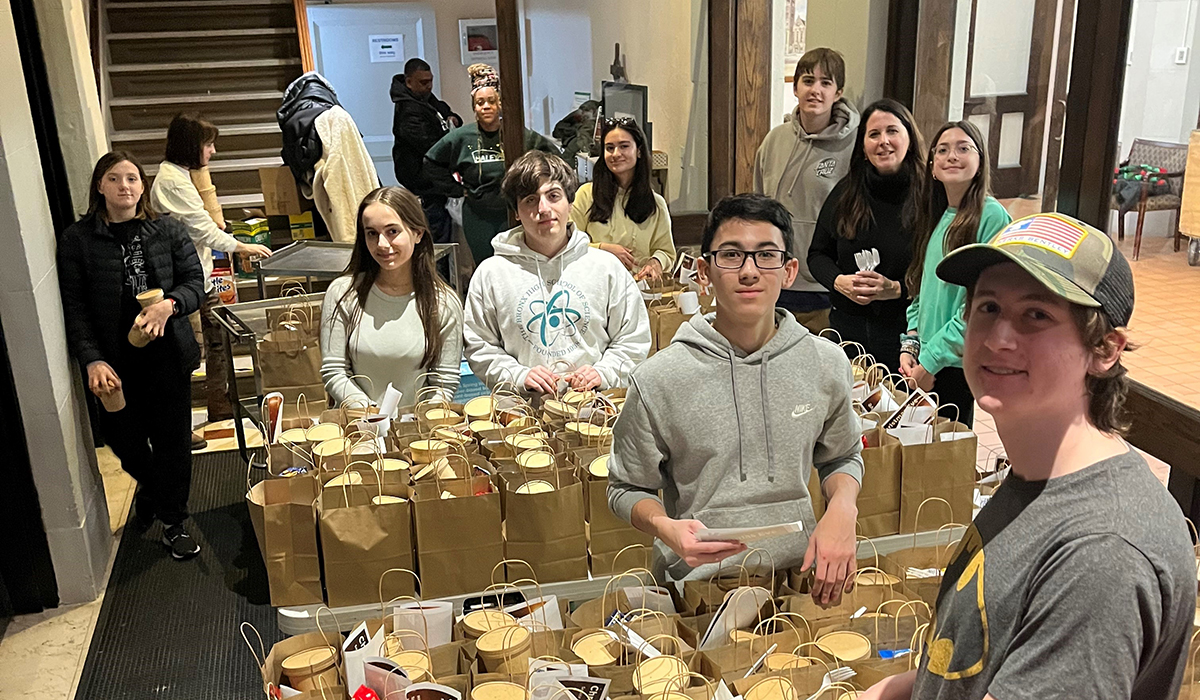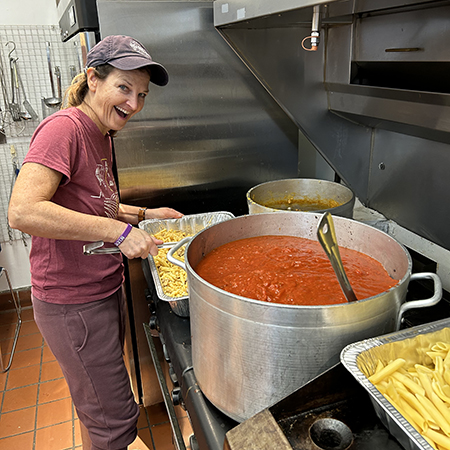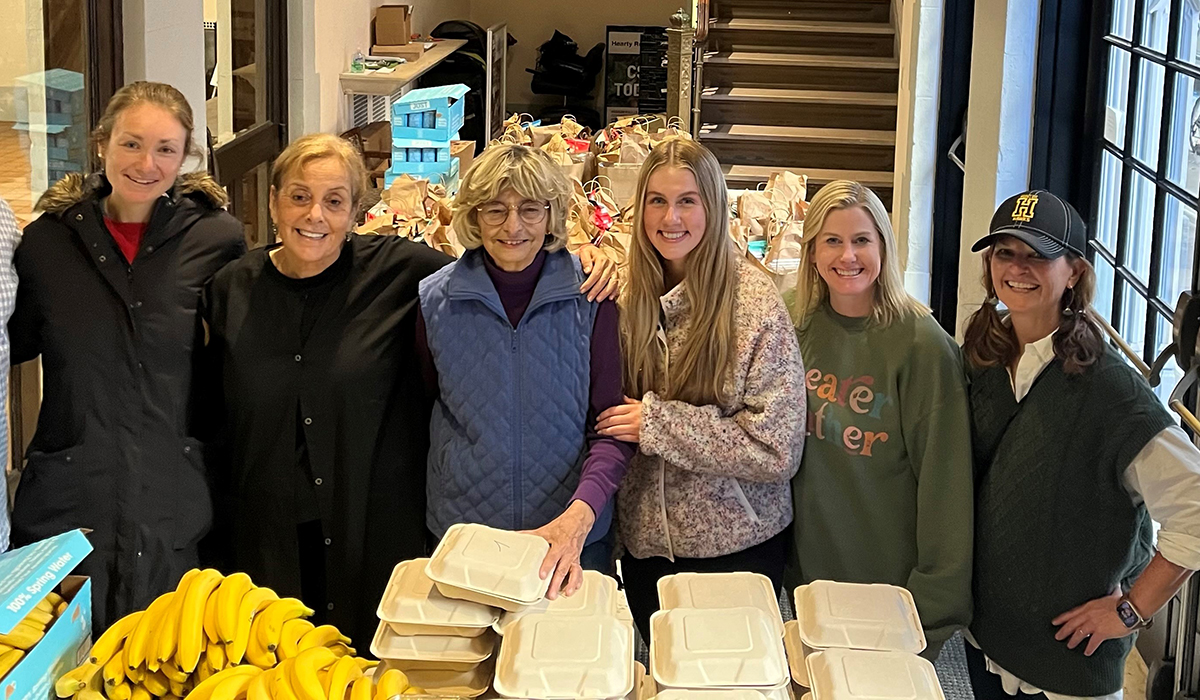Serving Food, Experiences and Plenty More

Meet Daily Point of Light Award honoree Kim Hodges. Read her story, and nominate an outstanding volunteer or family as a Daily Point of Light.
Kim Hodges, a native small-town Illinoisian, has lived in New York City for almost 30 years. She works in a field-based marketing role at a pharmaceutical company and plays softball in Central Park. But leading the Ulla Farmer Meal Program has become an inextricable part of her story, and she wouldn’t have it any other way.
Kim took the reins during the COVID-19 pandemic when she and her twin daughters—high schoolers, at the time—covered for the over 65 crowd that couldn’t safely volunteer. She reorganized the program to function with safety protocols and nearly tripled the number of people fed. Guests are appreciative to have a reliable meal each week and look forward to the experience as much as the volunteers do. Adding events and special touches to the program, she continues to honor the memory and legacy of the program’s creator after her passing.
What inspires you to volunteer?
I grew up in a family restaurant, so service was really ingrained. Everyone in my family is hardwired for it. It feels great when you do things for other people.

What inspired you to get started with this initiative?
I was a deacon in my church, and one of the initiatives we have is this Thursday meal program. Ulla Farmer started it 40 years ago, and it had grown and blossomed. As she was starting to step back from it in 2018, I was asked to coordinate volunteers. So, I started by organizing who was going to work each week.
When COVID hit, recommended precautions kept our volunteers, all of whom were over 65, from helping in-person. So, as we were trying to figure out how to continue, my daughters and I met one other person from the church and took over. It was such a great thing to be involved with, especially during COVID. It gave me purpose.
Tell us about your volunteer role with the Ulla Farmer Meal Program.
For many years, people would have a sit-down meal and a movie. Then, in the pandemic, we shifted to grab-and-go meals. Now, each week, five to seven of us pack sandwiches and healthy snack bags. In winter months, we add a hot meal. During those months, I organize a Saturday where we cook enough for the month. I still coordinate volunteers and manage Costco runs for hot meal ingredients and online supply deliveries for everything else.
We went from feeding around 55 people to around 160. Every week since the pandemic, it’s grown. We also add special touches. At Thanksgiving, for example, we’ve invited guests to either take the bag to go or sit down for a meal. At Christmas, we’ll organize a gift bag with things like socks, hats, gloves and sweet things.
We also made the third Thursday of every month Teen Night. Most of the guests are seniors, and it brings them so much joy when the kids are the ones handing out the bags. In May, we even worked with a clinic to have a health truck come and offer services. I’m constantly trying to think of ways we can do more.
Are guests typically the same each week?
A large portion of guests we see every week are. We may be the only people they talk to that day, so I remind volunteers to say hello and ask how they’re doing. We get new people every week as well. With all the immigration stuff going on, we’ve started seeing more young families, and that’s really heartbreaking. When our teens are handing out a meal to another teenager, that’s tough.
What are your long-term plans or goals for the organization?
We have free community programs on Tuesdays that aren’t part of the church. They use the space for things like chair yoga and improv night. I’m trying to tie some of that into our Thursday meals. Once, we had a concert for guests while they ate in the sanctuary. Another goal is to provide a warm and dry environment for them to enjoy their meal during extreme weather.
Tell us about Ulla Farmer.
Olla founded the program with tea and cookies and grew it into a hot, sit-down meal. She wanted it to be an experience, so volunteers waited tables and used real plates. I don’t think we could go back to that, because we would only be able to serve 50 people. But by adding programming, I’m trying to keep that aspect going in honor of her.

What’s been the most rewarding part of your work?
My dad was a chef, so when we’re cooking these huge volumes of food, I’m always thinking of him. It’s a way to feel connected to him. I also love the connection between youth and seniors, and amongst the volunteers and guests we serve. That’s one of the most rewarding things about the whole program. It’s so important. With everybody’s face in a computer or phone today, this is a way to really have a human connection.
What have you learned through your experiences as a volunteer?
One of the Boy Scouts from the church interviewed our guests for an Eagle Scout initiative. When he gave a speech about it, he talked about how much he learned and how important it is to be kind, because you never know what somebody’s story is.
That resonated with me. This program is such an easy way to show kindness and to carry that with you all week. When you see somebody on the street who isn’t behaving in a way they should be, you don’t know what’s behind it. So, I’ve learned to be kind in every action.
What do you want people to learn from your story?
Even a small act of kindness can make a big difference in the world. When people come and help, they’re touched by how meaningful the experience is. I love doing this. Taking time to find that thing–whatever it is–when you volunteer will be more rewarding than you can imagine.
Do you want to make a difference in your community like Kim? Find local volunteer opportunities.
